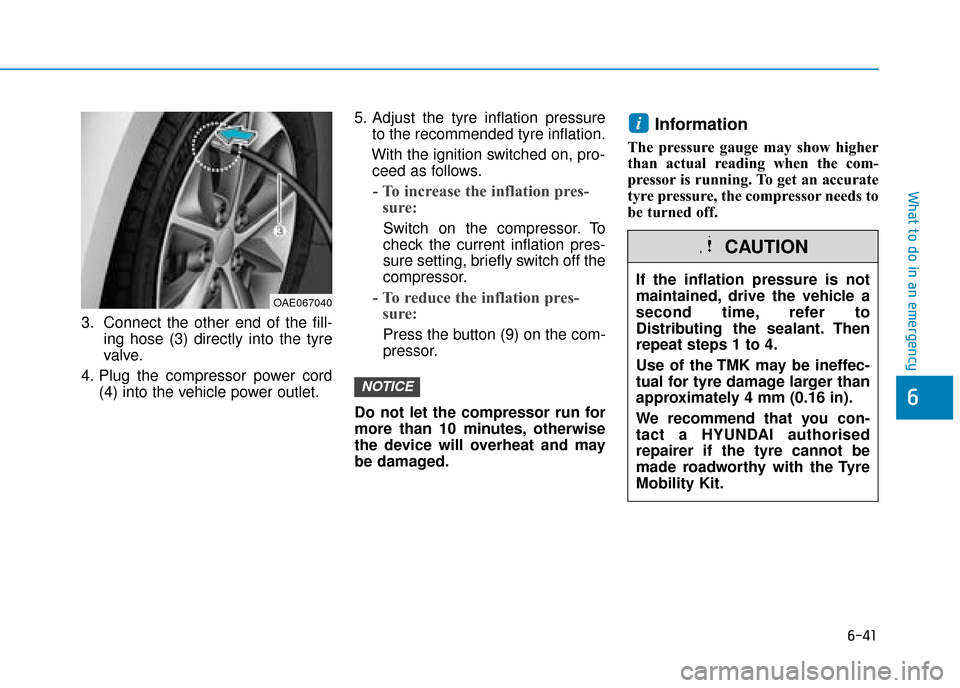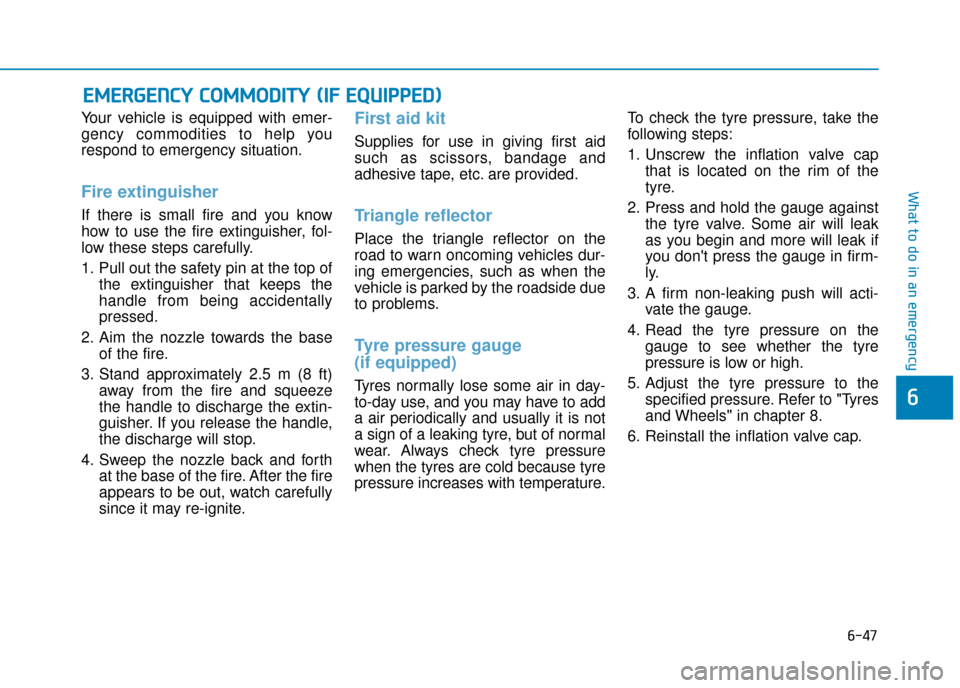Page 498 of 599
6-37
What to do in an emergency
1. Speed restriction label
2. Sealant bottle and label withspeed restriction
3. Filling hose from sealant bottle to wheel
4. Connectors and cable for power outlet direct connection
5. Holder for the sealant bottle
6. Compressor
7. ON/OFF switch
8. Pressure gauge for displaying the tyre inflation pressure
9. Button for reducing tyre inflation pressure
Connectors, cable and connection
hose are stored in the compressor
housing.
Strictly follow the specified sequence,
otherwise the sealant may escape
under high pressure.
6
Components of the Tyre Mobility Kit
ODE067044
Page 500 of 599
6-39
What to do in an emergency
4. Unscrew the valve cap from thevalve of the defective and screw
the filling hose (3) of the sealant
bottle onto the valve. 5. Plug the compressor power cord
(4) into the vehicle power outlet.
6. With the With the vehicle ON ( indicator ON), switch on the com-
pressor and let it run for approxi-
mately 5~7 minutes to fill the
sealant up to proper pressure.
(Refer to the Tyre and Wheels,
chapter 8). The inflation pressure
of the tyre after filling is unimpor-
tant and will be checked/corrected
later.
Be careful not to overinflate the
tyre and stay away from the tyre
when filling it.
6
Securely install the sealant fill-
ing hose to the valve. If not,
sealant may flow backward,
possibly clogging the filling
hose.
CAUTION
OAE066027
OAE067040OAEPH047541R
Page 501 of 599

6-40
7. Switch off the compressor.
8. Detach the hoses from the sealantbottle connector and from the tyre
valve.
Return the Tyre Mobility Kit to its
storage location in the vehicle.
Distributing the sealant
9. Immediately drive approximately 4~6 miles (7~10 km or about 10
minutes) to evenly distribute the
sealant in the tyre.
Do not exceed a speed of 50 mph
(80 km/h). If possible, do not fall
below a speed of 12 mph (20 km/h).
Whilst driving, if you experience any
unusual vibration, ride disturbance or
noise, reduce your speed and drive
with caution until you can safely pull
off of the side of the road.
Call for road side service or towing.
Checking the tyre inflation pressure
1. After driving approximately 4~6
miles (7~10 km or about 10 min-
utes), stop at a safe location.
2. Connect the filling hose (3) direct- ly into the compressor.
What to do in an emergency
Do not attempt to drive your
vehicle if the tyre pressure is
below 200 kpa (29 psi). This
could result in an accident due
to sudden tyre failure.
CAUTION
Do not leave your vehicle run-
ning in a poorly ventilated area
for extended periods of time.
Carbon monoxide poisoning
and suffocation can occur.
WARNING
OLMF064106
OAEPH067042
Page 502 of 599

6-41
What to do in an emergency
3. Connect the other end of the fill-ing hose (3) directly into the tyre
valve.
4. Plug the compressor power cord (4) into the vehicle power outlet. 5. Adjust the tyre inflation pressure
to the recommended tyre inflation.
With the ignition switched on, pro- ceed as follows.
- To increase the inflation pres- sure:
Switch on the compressor. To
check the current inflation pres-
sure setting, briefly switch off the
compressor.
- To reduce the inflation pres- sure:
Press the button (9) on the com-
pressor.
Do not let the compressor run for
more than 10 minutes, otherwise
the device will overheat and may
be damaged.
Information
The pressure gauge may show higher
than actual reading when the com-
pressor is running. To get an accurate
tyre pressure, the compressor needs to
be turned off.
i
NOTICE6
If the inflation pressure is not
maintained, drive the vehicle a
second time, refer to
Distributing the sealant. Then
repeat steps 1 to 4.
Use of the TMK may be ineffec-
tual for tyre damage larger than
approximately 4 mm (0.16 in).
We recommend that you con-
tact a HYUNDAI authorised
repairer if the tyre cannot be
made roadworthy with the Tyre
Mobility Kit.
CAUTION
OAE067040
Page 503 of 599
6-42
Information
When reinstalling the repaired or
replaced tyre and wheel on the vehi-
cle, tighten the wheel lug nut to 11~13
kgf·m (79~94 lbf·ft).
i
What to do in an emergencyTyre pressure sensor
(if equipped with TPMS)
The sealant on the tyre pres-
sure sensor and wheel should
be removed when you replace
the tyre with a new one and
inspect the tyre pressure sen-
sors at an authorised repairer.
CAUTION
The tyre inflation pressure must
be at least 220 kPa (32 psi). If it
is not, do not continue driving.
Call for road side service or
towing.
WARNING
Page 508 of 599

6-47
What to do in an emergency
6
Your vehicle is equipped with emer-
gency commodities to help you
respond to emergency situation.
Fire extinguisher
If there is small fire and you know
how to use the fire extinguisher, fol-
low these steps carefully.
1. Pull out the safety pin at the top ofthe extinguisher that keeps the
handle from being accidentally
pressed.
2. Aim the nozzle towards the base of the fire.
3. Stand approximately 2.5 m (8 ft) away from the fire and squeeze
the handle to discharge the extin-
guisher. If you release the handle,
the discharge will stop.
4. Sweep the nozzle back and forth at the base of the fire. After the fire
appears to be out, watch carefully
since it may re-ignite.
First aid kit
Supplies for use in giving first aid
such as scissors, bandage and
adhesive tape, etc. are provided.
Triangle reflector
Place the triangle reflector on the
road to warn oncoming vehicles dur-
ing emergencies, such as when the
vehicle is parked by the roadside due
to problems.
Tyre pressure gauge
(if equipped)
Tyres normally lose some air in day-
to-day use, and you may have to add
a air periodically and usually it is not
a sign of a leaking tyre, but of normal
wear. Always check tyre pressure
when the tyres are cold because tyre
pressure increases with temperature. To check the tyre pressure, take the
following steps:
1. Unscrew the inflation valve cap
that is located on the rim of the
tyre.
2. Press and hold the gauge against the tyre valve. Some air will leak
as you begin and more will leak if
you don't press the gauge in firm-
ly.
3. A firm non-leaking push will acti- vate the gauge.
4. Read the tyre pressure on the gauge to see whether the tyre
pressure is low or high.
5. Adjust the tyre pressure to the specified pressure. Refer to "Tyres
and Wheels" in chapter 8.
6. Reinstall the inflation valve cap.
E E M
M E
ER
R G
G E
EN
N C
CY
Y
C
C O
O M
M M
MO
OD
DI
IT
T Y
Y
(
( I
IF
F
E
E Q
Q U
UI
IP
P P
PE
ED
D )
)
Page 510 of 599

Tyres and wheels .................................................7-29
Tyre care ........................................................................\
...7-29
Recommended cold tyre inflation pressures ...........7-30
Check tyre inflation pressure ......................................7-31
Tyre rotation ....................................................................7-32\
Wheel alignment and tyre balance.............................7-33
Tyre replacement ............................................................7-33
Wheel replacement .........................................................7-34
Tyre traction ...................................................................7-34
Tyre maintenance ...........................................................7-35
Tyre sidewall labeling .....................................................7-35
Low aspect ratio tyres...................................................7-39
Fuses ......................................................................7-\
40
Instrument panel fuse replacement ...........................7-41
Engine compartment panel fuse replacement.........7-42
Fuse/relay panel description .......................................7-44
Light bulbs.............................................................7-54
Headlamp, position lamp, turn signal lamp
bulb replacement .............................................................7-55
Headlamp aiming .............................................................7-59
Daytime running lamp ....................................................7-62
Side repeater lamp replacement .................................7-62
Rear combination lamp bulb replacement ................7-63
Rear fog lamp ..................................................................7-68
High mounted stop lamp ...............................................7-68
License plate light bulb replacement .........................7-68
Interior light bulb replacement ....................................7-68
Appearance care ..................................................7-70
Exterior care ....................................................................7-70\
Interior care......................................................................7-\
75
Emission control system .....................................7-77
Crankcase emission control system ...........................7-78
Evaporative emission control system.........................7-78
Exhaust emission control system ...............................7-78
Procedure for entering forced
engine activation mode .......................................7-81
Page 515 of 599

7-7
7
Maintenance
Owner maintenance schedule
When you stop for fuel:
Check the engine oil level.
Check the coolant level in theengine coolant reservoir.
Check the windscreen washer fluid level.
Check for low or under-inflated tyres.
Whilst operating your vehicle:
Note any changes in the sound ofthe exhaust or any smell of
exhaust fumes in the vehicle.
Check for vibrations in the steering wheel. Notice if there is any
increased steering effort or loose-
ness in the steering wheel, or
change in its straight-ahead posi-
tion.
Notice if your vehicle constantly turns slightly or “pulls” to one side
when travelling on smooth, level
road.
When stopping, listen and check for unusual sounds, pulling to one
side, increased brake pedal travel
or “hard-to-push” brake pedal.
If any slipping or changes in the operation of your transmission
occurs, check the transmission
fluid level.
Check the dual clutch transmission P (Park) function.
Check the parking brake.
Check for fluid leaks under your vehicle (water dripping from the air
conditioning system during or after
use is normal).
At least monthly:
Check coolant level in the enginecoolant reservoir.
Check the operation of all exterior lights, including the stoplights, turn
signals and hazard warning flashers.
Check the inflation pressures of all tyres including the spare for tyres
that are worn, show uneven wear,
or are damaged.
Check for loose wheel lug nuts.
At least twice a year: (i.e., every Spring and Autumn)
Check radiator, heater and air condi-
tioning hoses for leaks or damage.
Check windscreen washer spray and wiper operation. Clean wiper
blades with a clean cloth damp-
ened with washer fluid.
Check headlamp alignment.
Check muffler, exhaust pipes, shields and clamps.
Check the seat belts for wear and function.
Be careful when checking your
engine coolant/inverter coolant
level when the engine is hot.
This may result in coolant being
blown out of the opening and
cause serious burns and other
injuries.
WARNING